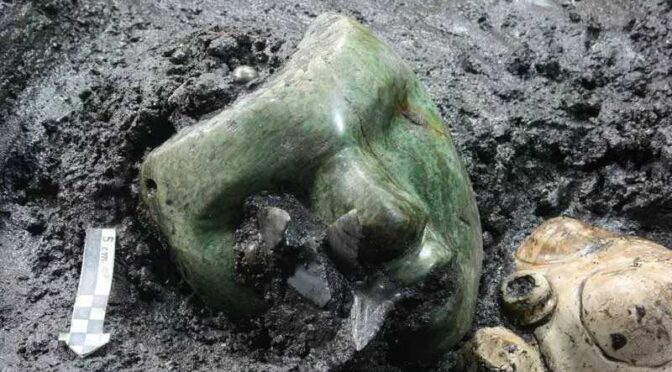2,000-Year-Old Realistic Green Mask Found Nestled Inside an Ancient Pyramid
Mexico has many remarkable archaeological sites that provide insight into its pre-Columbian history. Among the most impressive structures is the Pyramid of the Sun, which continues to reveal amazing discoveries.
Built approximately in 100 CE, this pyramid is the largest structure in Teotihuacan and has been under continuous research by archaeologists.
Although few artifacts have been unearthed on-site, in 2011,researchers from Mexico’s National Institute of Anthropology and History (INAH) made a surprising discovery using a 380-foot-long tunnel excavated by archaeologists in the 1930s.
By using the tunnel, the team was able to reach the mother-rock level. Upon arrival, they discovered a valuable assortment of artifacts, such as fragments of clay pottery, animal bones, obsidian pieces, three serpentine human figurines, and a remarkable “Green” serpentine mask. The green mask holds significant interest as, during its unearthing, it was the sole mask of its type discovered in a ritual context in Teotihuacan.
According to a statement by INAH, the discovery comprises 11 ceremonial clay pots dedicated to a rain god resembling Tlaloc. The findings also included animal bones, such as rabbits fed to eagles, and feline and canine remain yet to be identified.
These offerings were placed on a rubble base where the temple was built around 50 AD. It is noteworthy that Tlaloc was still revered in the region even after 1,500 years.
These offerings were believed to be deposited as part of a ritual to inaugurate the pyramid’s construction, which explains their location at the lower level. The discovery of this mask was particularly noteworthy because it depicted a human face with remarkable accuracy and simplicity.
This is significant due to the importance of masks in indigenous people’s religious practices. The Aztecs, in particular, were a culture that placed great value on masks, as noted by renowned anthropologist Claude Lévi-Strauss.
There are numerous types of masks, both intended for wear and crafted as miniature versions, possibly for use as amulets. With a history of mask-making in the region spanning millennia, ranging from rudimentary pottery to intricate art pieces, the diversity of masks would have been remarkable, given their various shapes and forms.
Unfortunately, only a limited number of masks have been discovered despite the estimated abundance of them, but the depictions of masks throughout history strongly suggest that many more existed over the centuries.
The Pyramid of the Sun, known today as the world’s third-largest pyramid, was named by the Aztecs who visited Teotihuacan centuries after its abandonment. The original name of the pyramid remains a mystery.
Teotihuacan was once a flourishing city known as the City of the Gods, with a population of 200,000 at its peak. However, researchers have yet to learn about the people who inhabited this city and why they disappeared.
In the Aztec culture, masks played an essential role in religious ceremonies as they were meant to represent one of their many gods. The Aztecs were known for their artistic skills and colorful masks.
However, the few masks discovered so far had strong symbolism, such as animal features or distorted proportions compared to humans.
Some scholars suggest that individuals did not wear masks during their duties. Instead, they were placed on holders or over a skull, sent as tokens to other rulers and chiefs, or used as death masks.
This might explain why some masks were not carved out to allow the wearer to see. Despite this, most of the masks showed some elaboration or alteration of the human figure.
Masks have played a central role in the religion and rituals of Mesoamerican civilizations for millennia. Therefore, finding a mask resembling a buried person is unique.
New archaeological findings in the future may shed more light on this discovery, the site at large, and the beautiful Mesoamerican cultures.

The National Institute of Anthropology and History (INAH) has been researching to uncover more information about the ancient civilization of Teotihuacán.
One of the recent discoveries made by INAH was an underground tunnel found beneath the Pyramid of the Moon. The use of electrical resistance technology enabled the mapping of the tunnel without the need for ground excavation.
The tunnel leads to an underground chamber, preceded by a chamber measuring 49 feet in diameter. This newly discovered chamber may hold more treasures. The accumulation of these findings will hopefully provide more insight into the civilization of Teotihuacán and reveal more information about its decline.
Verónica Ortega, the director of the Integral Conservation Project for the Plaza of the Moon, explains that the large offering complexes constitute the sacred heart of Teotihuacan, making it a mecca for civilization.
The discoveries made within these complexes can help to unravel the relationship that the ancient metropolis had with other regions of Mesoamerica.
